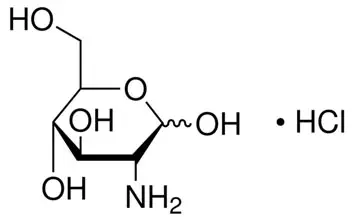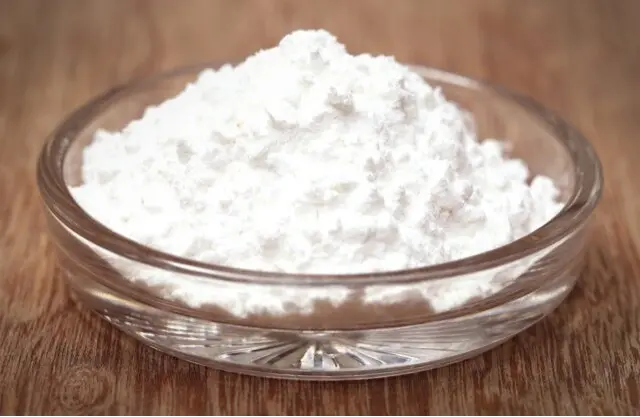What are the benefits of glucosamine hydrochloride?
What are the benefits of glucosamine hydrochloride?
What is glucosamine hydrochloride?
Glucosamine hydrochloride (D-glucosamine hydrochloride) is an amino sugar and a precursor of the hexosamine biosynthesis pathway. It can lead to the formation of UDP-N-acetylglucosamine (UDP-GlcNAc), which is then used to prepare glycosaminoglycans, proteoglycans and glycolipids. In addition, it can inhibit the coaggregation of Candida yeast strains and bacterial strains Streptococcus salivarius.
Glucosamine hydrochloride is a white crystalline powder. It has high solubility in water and low solubility in organic solvents such as methanol. The substance is odorless but slightly sweet. Under normal storage conditions, it is a stable compound, but contact with strong oxidants should be avoided because it is flammable.
The chemical stability of glucosamine hydrochloride is manifested in its ability to coexist with a variety of chemicals without chemical reactions. For example, during food processing, it can maintain its chemical structure unchanged and provide the required glucosamine hydrochloride ions for food. In addition, due to its strong acidity, it can exist stably in an acidic environment and is not easy to react with other acidic substances.
Glucosamine hydrochloride is a marine biological preparation extracted from natural chitin. It can promote the synthesis of human mucopolysaccharides, increase the viscosity of synovial fluid, improve the metabolism of articular cartilage, facilitate the repair of articular cartilage, and has obvious anti-inflammatory and analgesic effects.

What are the production methods of glucosamine hydrochloride?
Microbial fermentation is one of the main methods for producing glucosamine hydrochloride at present. This method mainly uses glucose as raw materials and is made through fermentation, acidification, filtration, concentration and other processes. The characteristics of this production method are high conversion efficiency, stable product quality, low production cost, no fishy smell, and unlimited production resources. In addition, by using metabolic engineering to improve strains, engineered bacteria with extremely high yields can also be obtained, which has the potential for large-scale industrial production.
Chemical synthesis is another traditional method for producing glucosamine hydrochloride. This method mainly extracts chitin or chitosan from shrimp and crab shells, and then obtains glucosamine by acid hydrolysis or enzymatic hydrolysis. However, this method has some defects, such as the need to use a large amount of concentrated hydrochloric acid in the process, which will cause serious industrial pollution; and the production cost of the enzymatic hydrolysis method is high and the efficiency is low.
Another method is to use Escherichia coli to ferment glucosamine. In this case, Escherichia coli, Bacillus subtilis, and Staphylococcus are seed activated to obtain a mixed fermentation agent, which is then inoculated into a fermentation medium containing glucose and a nitrogen source for constant temperature shaking culture. The fermentation process is carried out by constant feeding, and ammonia water is used to control the fermentation pH to 6.8-7.0, and finally a fermentation liquid containing glucosamine is obtained. After separation and purification, glucosamine can be obtained.

What are the effects of glucosamine hydrochloride?
1. Repair and regeneration of joint cartilage
Glucosamine hydrochloride can stimulate the synthesis of endogenous aminoglucan and collagen in the joint, thereby promoting the growth of chondrocytes and the biosynthesis of matrix. The purpose of repair and regeneration is achieved by promoting the growth of chondrocytes and the biosynthesis of matrix.
2. Anti-inflammatory effect
Glucosamine hydrochloride has the effect of inhibiting the production of proinflammatory factors such as interleukin-1β, reducing inflammatory cell infiltration and reducing tissue damage. It exerts anti-inflammatory effects by inhibiting the production of proinflammatory factors, reducing inflammatory cell infiltration and reducing tissue damage.
3. Increase joint fluid secretion
Glucosamine hydrochloride can stimulate the proliferation of synovial cells and the secretion of hyaluronic acid, thereby increasing the secretion of joint fluid. Joint fluid lubricates the joint surface, reduces friction and wear, and protects the joint cartilage from damage.
4. Improve joint flexibility
Glucosamine hydrochloride can promote the synthesis of proteoglycans by chondrocytes, enhance the elasticity and toughness of cartilage; at the same time, it can also promote the secretion of joint fluid, so that the joint surface is fully lubricated, thereby improving joint flexibility. Synovial fluid lubricates the joint surface, reduces friction and collision between joints, and prevents cartilage damage.
5. Lowers blood lipids
Glucosamine hydrochloride can help lower blood lipid levels. It can reduce blood cholesterol and triglyceride levels by inhibiting the absorption and synthesis of fat, thereby preventing the occurrence of cardiovascular diseases such as atherosclerosis.
How does glucosamine hydrochloride affect the metabolism of articular cartilage?
1. Promote cartilage matrix synthesis
Glucosamine hydrochloride can selectively act on bony joints, stimulating chondrocytes to produce glycoproteins with normal polymer structures, especially proteoglycans, which are important components of cartilage matrix.
Glucosamine is a precursor substance for chondrocytes to synthesize proteoglycans, which can promote the synthesis of proteoglycans, thereby enhancing the toughness and elasticity of cartilage matrix.
2. Inhibit cartilage degradation
Glucosamine hydrochloride can inhibit enzymes that damage cartilage, such as collagenase and phospholipase A2. These enzymes participate in the degradation process of cartilage matrix under normal circumstances, but will cause excessive degradation of cartilage matrix under pathological conditions such as arthritis.
Glucosamine also has certain antioxidant properties, which can reduce the oxidative stress response of chondrocytes and prevent chondrocyte damage and cartilage matrix degradation caused by oxidative stress.
3. Improve the quality of synovial fluid
Glucosamine hydrochloride is metabolized into hyaluronic acid in the body, which is one of the main components of synovial fluid and has the function of lubricating the joint surface and reducing friction. Glucosamine can improve joint lubrication and reduce cartilage wear by increasing the viscosity of synovial fluid.
Glucosamine can also stimulate and replenish synovial fluid in large quantities for the human body, thereby continuously lubricating the articular cartilage surface and helping to protect the cartilage from mechanical damage.
4. Anti-inflammatory effect
Glucosamine hydrochloride can inhibit the expression of pro-inflammatory factors such as interleukin-1β, which promote the degradation of cartilage matrix and inflammatory response in pathological conditions such as arthritis.
Glucosamine can also induce macrophages to secrete anti-inflammatory mediators such as nitric oxide synthase, thereby exerting anti-inflammatory effects and reducing joint inflammatory responses.
What are the application fields of glucosamine hydrochloride?
Food field
In the food field, glucosamine hydrochloride, as a nutritional additive, can be used in dairy foods, meat foods, baked foods, pasta foods, aquatic products, various beverages, seasoning foods, etc. In addition, because it can enhance human immunity, glucosamine hydrochloride has also become a very popular health product.
Cosmetic field
In the cosmetic field, glucosamine hydrochloride can be used as a natural moisturizer and agent to help maintain skin health. It is used to make various skin care products, cosmetics, shampoos and other beauty products, which can promote skin health and reduce wrinkles and spots.
Medical field
Glucosamine hydrochloride is widely used in the medical field. It can be used to make drugs for the treatment of rheumatoid arthritis, ulcers, and enteritis.
_1737093401309.png)
